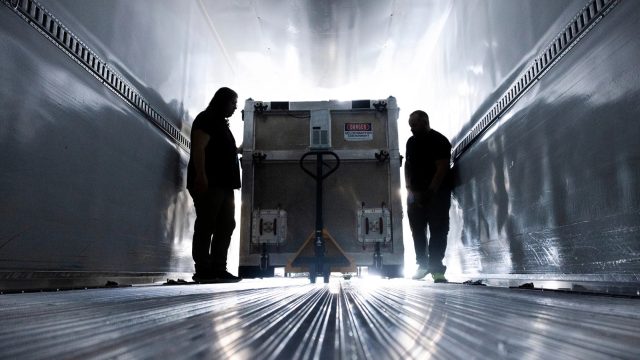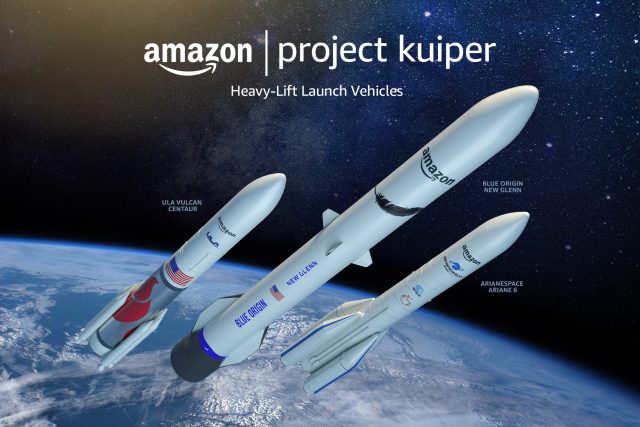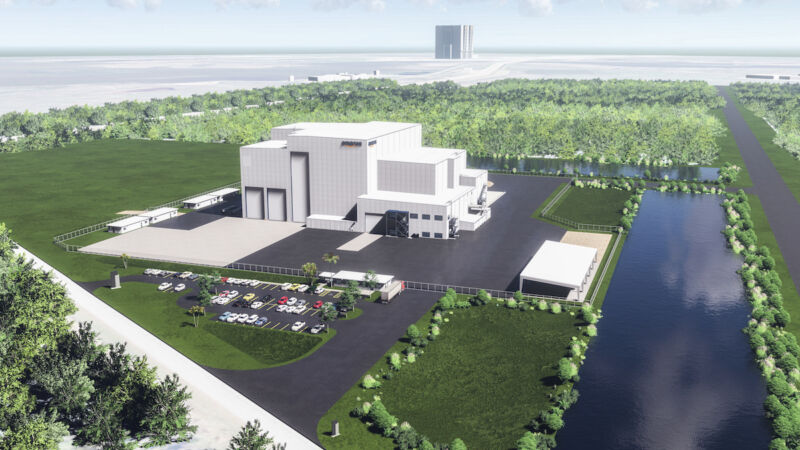Within a few years, Amazon hopes to be building and launching up to 80 satellites per month to populate the company's Kuiper constellation, a $10 billion network that is similar to fleets already operated by SpaceX and OneWeb providing Internet connectivity around the world.
In the next six months, Amazon plans to begin production of operational Kuiper satellites at a new 172,000-square-foot factory in Kirkland, Washington. On Friday, officials from Amazon and the Florida government announced that a 100,000-square-foot facility under construction at NASA's Kennedy Space Center will serve as a satellite processing facility dedicated to the Kuiper program.
Inside this facility near the old space shuttle landing strip, engineers will mount Kuiper satellites onto huge orbital deployer mechanisms standing several stories tall, then encapsulate the structure inside the nose cones of their rockets. The fully integrated payload compartments will then move out to launch pads operated by United Launch Alliance and Blue Origin—the space company established by Amazon founder Jeff Bezos—at Cape Canaveral Space Force Station, a few miles away.
The new structure is being built on land leased by NASA to Space Florida, a state-funded economic development agency focused on luring commercial space companies to the Sunshine State. It has a high bay that will stand about 100 feet (30 meters) tall, big enough to house the payload fairings of ULA and Blue Origin's heavy-lift rockets. Amazon says it is investing about $120 million in the new facility, which is sized to accommodate up to three simultaneous launch campaigns.
“One of the places that makes this facility so unique and such a great place to do business is the proximity to the launch providers and to the launch sites," said Brian Huseman, Amazon's vice president of public policy.
Amazon's Project Kuiper is one of several large "mega-constellations" either already in space or nearing launch. It's a competitor to SpaceX's Starlink network, which already has more than 4,000 satellites in orbit, and OneWeb's broadband constellation, numbering more than 600 spacecraft.
If you track this industry, you'll know that SpaceX is regularly launching its Starlink satellites in large batches aboard the company's own Falcon 9 rocket. These flights from Cape Canaveral and from Vandenberg Space Force Base, California, make up about half of SpaceX's missions over the last couple of years, with Starlink launches flying about once per week, on average.
Amazon's projected launch rate is almost as ambitious. The company aims to deploy about half of its 3,236 satellites by July 2026, a deadline to maintain network authorization from the Federal Communications Commission. That would require at least two launches per month, and perhaps more, from Amazon's stable of launch service providers.
The expected launch cadence requires a dedicated building to prepare the satellites for launch, Amazon officials said.

Amazon hasn't released any pictures or artist's illustrations of their Kuiper satellites, but this picture
of one of the spacecraft's shipping containers provides a sense of the size of each one.
Amazon
Last year, Amazon signed the largest commercial launch contract in history, snatching up rides on ULA's new Vulcan rocket, Blue Origin's New Glenn, and Arianespace's Ariane 6 launcher. All told, Amazon has purchased 77 launches: 38 Vulcan launches, plus nine flights on ULA's soon-to-retire Atlas V, 18 Ariane 6 rockets, and 12 New Glenn missions, with a contract option for 15 more.
That will cover Kuiper's launch service needs for its 3,200 satellites. But all those rockets, except for the Atlas V, are still in development. ULA's Vulcan appears like it will fly first of Amazon's crop of launch vehicles, probably followed by the European-built Ariane 6, and then Blue Origin's New Glenn.
SpaceX was not part of the launch contracts, and that wasn't a surprise since Amazon's Kuiper network will compete with Starlink. But OneWeb, another satellite broadband provider, inked a deal with SpaceX last year to launch its satellites on Falcon 9 rockets after launches on Russian rockets fell through in the wake of Russia's invasion of Ukraine.
Tired of waiting?
The first two prototype satellites for this new Kuiper constellation have been sitting in a climate-controlled clean room near Cape Canaveral, Florida, since March, waiting for a ride to space on the first test flight of United Launch Alliance's new Vulcan rocket, the replacement for the Atlas V and Delta IV launch vehicles. Amazon shipped the two satellites, believed to be in the range of a few hundred kilograms, from a factory near Seattle to Florida in preparation for a planned May launch on the Vulcan rocket.
But the Vulcan rocket's debut has been delayed until late this year, something that's not unusual for a brand new launch vehicle. That has left the payloads assigned to the first Vulcan launch in limbo. Besides Amazon's Kuiper test satellites, the first Vulcan flight is due to loft a commercial Moon lander from a Pittsburgh-company named Astrobotic. The payloads are all ready, but the rocket is not.
Astrobotic's lunar lander remains in Pittsburgh, and will ship to Florida once ULA sets a target launch date. That will only happen after engineers complete testing of the Vulcan rocket's Centaur upper stage, following an explosion caused by a hydrogen leak during a ground test earlier this year.
Steve Metayer, Amazon's vice president of Kuiper production operations, said the first two Kuiper satellites are "quietly sleeping" in a storage room in Florida. They’ve been in their dispenser ready to go, just waiting for our launch provider to give us a ride to space."
He said the plan to launch the first two Kuiper testbeds on the inaugural Vulcan rocket remains the company's "plan of record." But Metayer added: "Obviously, we’re always working with our partners to find other options.”
One of those alternatives, an Amazon official said, may be to move the two Kuiper prototypes to one of the Atlas V rockets Amazon has already booked. ULA has several Atlas Vs already delivered to Cape Canaveral, and those rockets are awaiting future missions.
There may be an opportunity for ULA to fit in an Atlas V mission for Amazon in the fall after some of the company's other customers—namely Viasat and Boeing's Starliner crew capsule—ran into delays. "ULA is a great partner for us. We’re always looking to benefit Kuiper. That is an option," the Amazon official told Ars.
A launch for the Kuiper prototypes in the fall "would be nice timing," the official added. "It would be ahead of December. Anything ahead of December right now would be beneficial to us.”
But the Kuiper program won't hit a roadblock if the test satellites remain on the ground a little longer.
“The test satellites really don’t pace us," Metayer said. "We can simulate launch dynamic loads in our laboratories. We can simulate, in our chambers, the space environment. Other than the distances and communicating through the atmosphere, we’ve tested on the ground everything we needed to vet out.
"We’re charging ahead with our production design that we have," he said. "We’ll start production of those at the end of this year. This prototype mission will give us knowledge and more confidence, but we’re going ahead with production.”
The new factory in Kirkland, Washington, will churn out four satellites per day when it's humming along at peak efficiency, according to Metayer. That's 20 satellites per week. Last year, launch industry officials said the Ariane 6 rocket will carry between 35 and 40 Kuiper satellites on each of Arianespace's missions for Amazon, the Vulcan Centaur can accommodate 45 Kuiper satellites per launch, and the New Glenn can haul 61 per flight.

Meet the Project Kuiper launch team
Amazon
The first two Kuiper test satellites were originally contracted to fly on a new rocket from the startup launch company ABL Space Systems. Last year, Amazon moved the satellites off of ABL's rocket and onto the first Vulcan launch with ULA.
Despite the rocket delays, Amazon is sticking with its three launch contractors, but the company has intentionally designed the Kuiper satellites to fit on a range of launch vehicles.
“We will have a lot of launch appetite for a long time," a Project Kuiper official said, adding that Amazon wouldn't rule out launching with SpaceX or another company in the future. "We have the first 77 covered. There will be more after that. We’re kind of looking at everybody."
"Ideally, we want a heavy-lift vehicle," the official said. "That’s why we’re with Vulcan. That’s why we signed a big contract with them. Their lift capacity is far bigger than a Falcon 9.”
Amazon hasn't released much detail about its satellites. Metayer said the Kuiper satellites are "three-dimensional" in shape, and not flat-packed on their rockets like SpaceX's Starlink spacecraft.
The 3,236 satellites currently in development are approved by the FCC to operate in mid-inclination orbits a few hundred miles above Earth, covering customers between 56 degrees north and south latitude. Some of the satellites could be re-targeted for polar orbits to enable more global coverage, a Kuiper official told Ars, but that would require another round of review and approval from federal regulators.
Betting big on ULA
Several Amazon executives toured ULA's launch facilities at Cape Canaveral Friday. Ars was among a handful of news organizations who joined the tour, where ULA outlined plans to double its launch capacity in Florida.
Amazon is helping fund a big expansion in ULA's footprint at the Florida spaceport. The investment to fund the growth in ULA's capacity for Kuiper launches totals about $2 billion, with around $500 million going toward upgrades at Cape Canaveral.
Those upgrades include the outfitting of a second vertical hangar and a second mobile launch platform for Vulcan rockets, alongside the integration facility and launch table already built to support the first few Vulcan missions. Having dual lanes for launch processing in Florida will allow ULA to fly as many as 25 Vulcan rockets per year, the company says. The primary Vulcan customers early on will be the US Space Force and Amazon.
ULA and its subcontractors are also expanding factory space at locations around the country to produce more Vulcan engines, solid rocket boosters, and payload fairings for the Kuiper missions.
A ULA official on Friday called the Kuiper contract "transformational" from the company, a 50-50 joint venture between Boeing and Lockheed Martin. ULA has seen its position in the US launch market eroded by SpaceX, but with Amazon's deep pockets and a lucrative launch contract with the Space Force in hand, the Vulcan rocket should have years of service ahead of it.




3175x175(CURRENT).thumb.jpg.b05acc060982b36f5891ba728e6d953c.jpg)


Recommended Comments
There are no comments to display.
Join the conversation
You can post now and register later. If you have an account, sign in now to post with your account.
Note: Your post will require moderator approval before it will be visible.